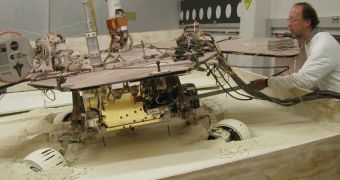While engineers at NASA's jet Propulsion Laboratory (JPL), in Pasadena, California, are working with the test rover, trying to find solutions on how to get Spirit out of Troy, the exploration rover is stuck on Mars, with nothing to do. Having collected an impressive number of images of its surroundings, the robot has now turned its cameras to the sky, and does astronomy as a “hobby.” The investigations have yielded clues about the Martian atmosphere at night, in terms of clouds, haze and air motion.
This is not the first time that Spirit turned its cameras upwards. During the four Martian winters it survived on the Red Planet, the robot has constantly photographed the skies, as the power levels it had were too low to allow it to drive anywhere. Now, that's not the case. Gusts of wind have removed most of the dust on its solar panels, and the machine experiences the largest amounts of power it has had in years. In fact, the reserves are so great, that they have enabled the crew operating it to make two transmissions per day, instead of the usual one.
“Certainly, a month or more ago, no one was considering astronomy with the rovers. We thought that was done. With the dust cleanings, though, everyone thinks it is better to use the new found energy on night time science than to just burn it with heaters,” Texas A&M University rover team member and Planetary Scientist Mark Lemmon told Universe Today's Nancy Atkinson in a June 27 report, Space informs.
“The Canopus images may become a regular occurrence, as a way to monitor dust and/or ice in the sky at night-much as we use Sun images in the day. For something like that, we can pick an aim (Canopus, Orion, etc.) and choose filters. We might use color filters to look for any differences that show up, or the clear filter for the most sensitive measurement. Star exposures can go up to 5.5 minutes. We cannot track stars, so they trail after 10 seconds or so-as you see Canopus doing. In longer exposures, hot pixels and cosmic rays show up as points or cluster of light,” he added in the same report.
In the meantime, efforts are being made at JPL using the test rover to determine the best possible scenario of removing Spirit from its sandy trap. The robot, which is similar to the two Mars Exploration Rovers (MER) in all aspects, has been inserted in a sandbox at the Caltech laboratory, and mission controllers are considering all possible maneuvers that would ensure that the Martian robot does not remain stuck in the ground. Once a viable scenario is devised on Earth, the same sequence will be transmitted to Mars, and Spirit will attempt to make its getaway.

 14 DAY TRIAL //
14 DAY TRIAL //